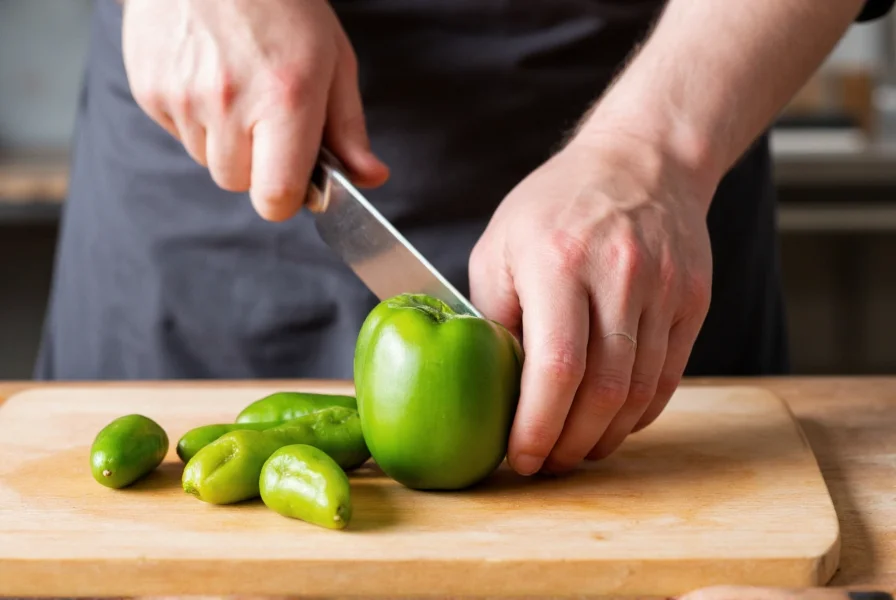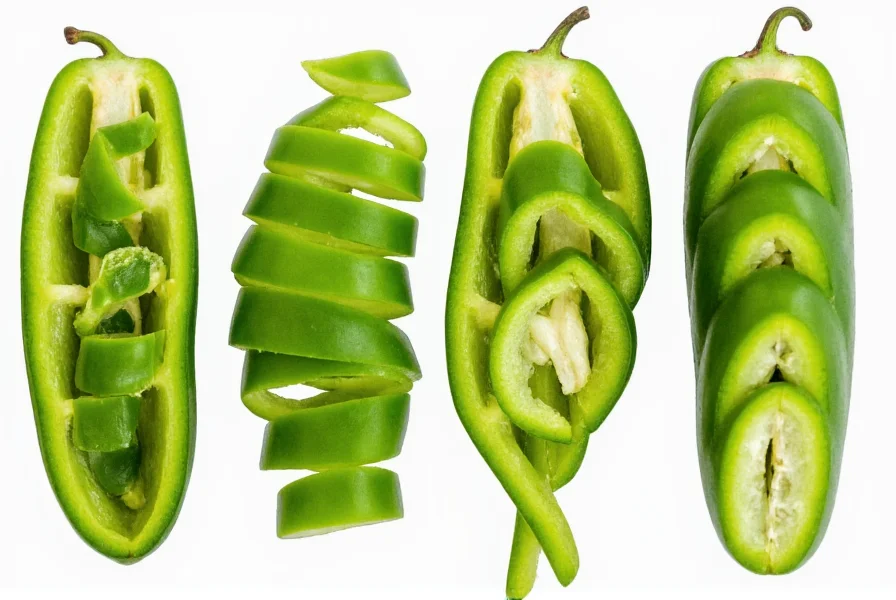Cutting green peppers properly ensures safety, efficiency, and optimal results for your cooking. Whether you're preparing a stir-fry, salad, or stuffed peppers, mastering this fundamental kitchen skill makes meal preparation smoother and more enjoyable. This comprehensive guide covers everything you need to know about how to cut a green pepper correctly for various culinary applications.
Essential Tools for Cutting Green Peppers
Before learning how to cut a green pepper, gather these kitchen essentials:
- Sharp chef's knife (8-10 inches)
- Stable cutting board (wood or plastic)
- Bowl for seed disposal
- Optional: paring knife for detailed work
Using a sharp knife is crucial for safe green pepper preparation. Dull blades require more pressure and increase slip risk. Always choose a knife that feels comfortable in your hand with a secure grip.

Safety First: Proper Knife Handling Techniques
Understanding how to cut green peppers safely prevents kitchen accidents. Follow these safety protocols:
- Position your cutting board on a non-slip surface
- Use the "claw grip" with non-knife hand (fingertips curled under)
- Maintain focus—never rush knife work
- Cut away from your body at all times
- Keep knives properly sharpened
Many home cooks wonder how to cut green peppers without injuring themselves. The key is maintaining proper hand positioning. Your guiding hand should always be behind the knife edge, with fingertips curled inward to protect them from accidental slips.
Step-by-Step Guide: How to Cut a Green Pepper
Follow these detailed instructions for perfect pepper preparation every time:
Step 1: Preparation
Wash the green pepper thoroughly under cool running water. Pat dry with a clean towel. Inspect for any blemishes or soft spots that might affect quality.
Step 2: Trim the Ends
Place the pepper vertically on your cutting board. Using a sharp knife, slice approximately ¼ inch from both the top (stem end) and bottom. This creates stable, flat surfaces.
Step 3: Remove the Core
Stand the pepper upright on one of the flat ends. Carefully insert your knife tip near the white core and cut vertically along the natural ridges. Repeat this process around the entire pepper to separate the four main sections from the central core.
Step 4: Seed Removal
Lay each pepper section flat, inner side up. Run your knife blade gently along the membrane to remove remaining seeds and white ribs. For recipes where texture matters, thorough seed removal prevents bitterness.
| Cutting Style | Best For | Knife Skill Level |
|---|---|---|
| Julienne (thin strips) | Stir-fries, fajitas | Intermediate |
| Dice (small cubes) | Salsas, omelets | Beginner |
| Wedges | Roasting, stuffing | Beginner |
| Rings | Burgers, pizzas | Intermediate |
Advanced Cutting Techniques
Once you've mastered the basic method of how to cut a green pepper, try these specialized techniques:
Perfect Dicing Method
For uniform diced peppers ideal for salsas or炒菜 (stir-fries), arrange your pepper sections flat. Make even lengthwise cuts, then rotate 90 degrees and slice across for consistent cubes. The size depends on your recipe—¼ inch for salads, ½ inch for stir-fries.
Julienne Cutting for Stir-Fries
When preparing how to cut green peppers for stir fry, julienne cuts work best. After removing seeds, stack several pepper sections and cut into thin matchstick pieces. This technique ensures even cooking and attractive presentation.
Pepper Rings for Sandwiches
To create perfect rings, stand the whole pepper upright and slice horizontally. Thinner slices work for sandwiches, while thicker rings hold up better for grilling. This method skips seed removal until after slicing.

Pro Tips for Green Pepper Preparation
Professional chefs know these valuable techniques when learning how to cut green peppers efficiently:
- Chill peppers briefly for firmer texture and easier handling
- Save seeds and membranes for vegetable stock (despite common belief, they're edible)
- Work in batches when meal prepping—cut multiple peppers at once
- Use a dedicated cutting board for vegetables to prevent flavor transfer
- Cut peppers just before use for maximum nutrient retention
Storing Cut Green Peppers Properly
After mastering how to cut a green pepper, proper storage maintains freshness:
- Place cut peppers in an airtight container
- Add a slightly damp paper towel to maintain humidity
- Store in the crisper drawer of your refrigerator
- Use within 3-4 days for best quality
Avoid washing peppers before storage, as excess moisture accelerates spoilage. For longer preservation, consider freezing cut peppers on a baking sheet before transferring to freezer bags.
Common Mistakes to Avoid
When learning how to cut green peppers, beginners often make these errors:
- Using a dull knife (increases accident risk)
- Leaving bitter white membranes intact
- Cutting uneven pieces that cook inconsistently
- Washing after cutting (dilutes flavor)
- Using excessive force instead of proper knife technique
Remember that proper knife skills develop with practice. Start slowly, focusing on safety and consistency rather than speed when learning how to cut green peppers correctly.
Frequently Asked Questions
Should I remove all seeds from green peppers?
While seeds are edible, most recipes benefit from seed removal as they can be bitter and affect texture. For stuffed peppers or roasting, you might leave some seeds for added flavor complexity. When learning how to cut green peppers for salads or stir-fries, complete seed removal typically yields better results.
Can I cut green peppers without a knife?
While a knife provides the cleanest cuts, you can tear green peppers with your hands for rustic dishes like frittatas or salads where precise shape isn't important. However, for most cooking applications requiring how to cut green peppers properly, a sharp knife remains essential for safety and consistency.
Why do my cut green peppers turn brown quickly?
Green peppers contain enzymes that cause browning when exposed to air. To prevent this when learning how to cut green peppers for meal prep, store them with a damp paper towel in an airtight container. Adding lemon juice can also slow oxidation but may affect flavor in some dishes.
How thin should I slice green peppers for stir-fry?
For perfect stir-fry results when learning how to cut green peppers for Asian cuisine, aim for ⅛ to ¼ inch thick julienne strips. This thickness ensures even cooking without becoming mushy. Thinner slices work for quick-cooking dishes, while slightly thicker pieces hold their shape better in longer cooking processes.
Can I use the same technique for all bell pepper colors?
Yes, the same cutting technique applies to all bell pepper varieties—green, red, yellow, and orange. The only difference is that riper peppers (red, yellow, orange) have thinner walls and may require slightly gentler handling. When learning how to cut green peppers, the skills transfer directly to other colors.











 浙公网安备
33010002000092号
浙公网安备
33010002000092号 浙B2-20120091-4
浙B2-20120091-4